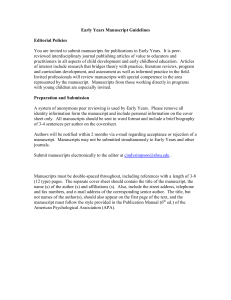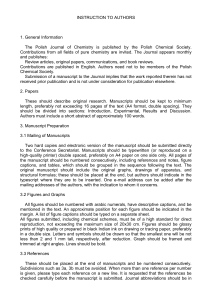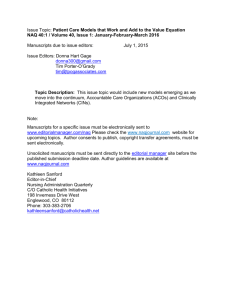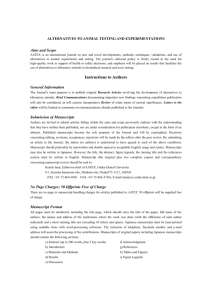Journal of Environmental Protection and Ecology – JEPE of B
advertisement
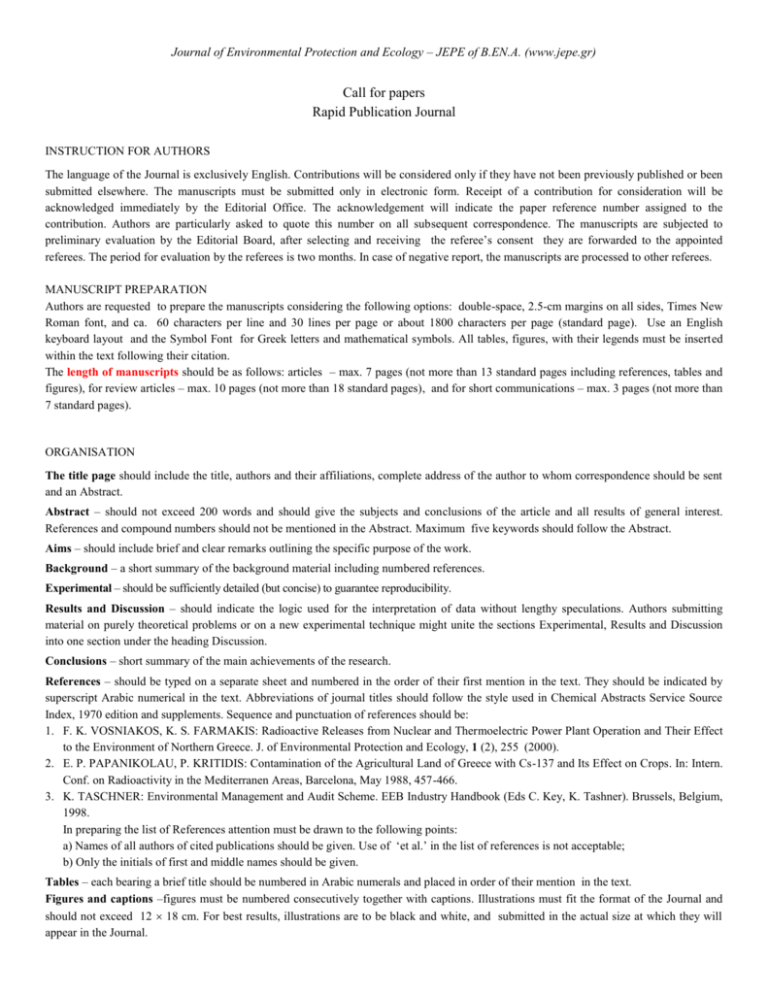
Journal of Environmental Protection and Ecology – JEPE of B.EN.A. (www.jepe.gr) Call for papers Rapid Publication Journal INSTRUCTION FOR AUTHORS The language of the Journal is exclusively English. Contributions will be considered only if they have not been previously published or been submitted elsewhere. The manuscripts must be submitted only in electronic form. Receipt of a contribution for consideration will be acknowledged immediately by the Editorial Office. The acknowledgement will indicate the paper reference number assigned to the contribution. Authors are particularly asked to quote this number on all subsequent correspondence. The manuscripts are subjected to preliminary evaluation by the Editorial Board, after selecting and receiving the referee’s consent they are forwarded to the appointed referees. The period for evaluation by the referees is two months. In case of negative report, the manuscripts are processed to other referees. MANUSCRIPT PREPARATION Authors are requested to prepare the manuscripts considering the following options: double-space, 2.5-cm margins on all sides, Times New Roman font, and ca. 60 characters per line and 30 lines per page or about 1800 characters per page (standard page). Use an English keyboard layout and the Symbol Font for Greek letters and mathematical symbols. All tables, figures, with their legends must be inserted within the text following their citation. The length of manuscripts should be as follows: articles – max. 7 pages (not more than 13 standard pages including references, tables and figures), for review articles – max. 10 pages (not more than 18 standard pages), and for short communications – max. 3 pages (not more than 7 standard pages). ORGANISATION The title page should include the title, authors and their affiliations, complete address of the author to whom correspondence should be sent and an Abstract. Abstract – should not exceed 200 words and should give the subjects and conclusions of the article and all results of general interest. References and compound numbers should not be mentioned in the Abstract. Maximum five keywords should follow the Abstract. Aims – should include brief and clear remarks outlining the specific purpose of the work. Background – a short summary of the background material including numbered references. Experimental – should be sufficiently detailed (but concise) to guarantee reproducibility. Results and Discussion – should indicate the logic used for the interpretation of data without lengthy speculations. Authors submitting material on purely theoretical problems or on a new experimental technique might unite the sections Experimental, Results and Discussion into one section under the heading Discussion. Conclusions – short summary of the main achievements of the research. References – should be typed on a separate sheet and numbered in the order of their first mention in the text. They should be indicated by superscript Arabic numerical in the text. Abbreviations of journal titles should follow the style used in Chemical Abstracts Service Source Index, 1970 edition and supplements. Sequence and punctuation of references should be: 1. F. K. VOSNIAKOS, K. S. FARMAKIS: Radioactive Releases from Nuclear and Thermoelectric Power Plant Operation and Their Effect to the Environment of Northern Greece. J. of Environmental Protection and Ecology, 1 (2), 255 (2000). 2. E. P. PAPANIKOLAU, P. KRITIDIS: Contamination of the Agricultural Land of Greece with Cs-137 and Its Effect on Crops. In: Intern. Conf. on Radioactivity in the Mediterranen Areas, Barcelona, May 1988, 457-466. 3. K. TASCHNER: Environmental Management and Audit Scheme. EEB Industry Handbook (Eds C. Key, K. Tashner). Brussels, Belgium, 1998. In preparing the list of References attention must be drawn to the following points: a) Names of all authors of cited publications should be given. Use of ‘et al.’ in the list of references is not acceptable; b) Only the initials of first and middle names should be given. Tables – each bearing a brief title should be numbered in Arabic numerals and placed in order of their mention in the text. Figures and captions –figures must be numbered consecutively together with captions. Illustrations must fit the format of the Journal and should not exceed 12 18 cm. For best results, illustrations are to be black and white, and submitted in the actual size at which they will appear in the Journal. Chemical Structures should be produced with the use of a drawing program such as ChemDraw or ChemWindows. Particular attention is drawn to the use of SI system of units, and IUPAC recommendations regarding symbols, units, and termonilogy. ELECTRONIC SUBMISSION OF MANUSCRIPTS Manuscripts should be submitted only in electronic form. Submission not in electronic form may face a delay in publication. All text (including the title page, abstract, keywords, all sections of the manuscript, figure captions, and references) and tabular material should be in one file, with the complete text first, followed by the tabular material. The manuscript must be prepared using MS Word 6.0 and above. Manuscripts in PDF are not accepted. Chemical equations must be supplied using equation editor. Tables must be created using table format feature. Graphics, i.e. figures, schemes, etc. should be in a separate file. The file name should be descriptive for the graphic. Structures and schemes may be supplied in ChemWindow format and other graphics in Microsoft Excell or Microsoft PowerPoint format. SUBMISSION OF MANUSCRIPTS Manuscripts should be sent to the following address: Prof., Dr. Fokion Vosniakos BALKAN ENVIRONMENTAL ASSOCIATION (B.EN.A.) Alexander Technological Educational Institution, P.O. Box 141, 57 400-Sindos, Thessaloniki, GREECE E-mail: bena@gen.teithe.gr; http://www.jepe.gr; http://www.ge.teithe.gr/~bena All manuscripts are subject to critical review and the names of referees will not be disclosed to the authors. The manuscript sent back to the author for revision should be returned within 2 months in duplicate. Otherwise it will be considered withdrawn. Revised manuscripts are generally sent back to the original referees for comments, unless (in case of minor revisions) the editors accept them without seeking further opinions. Proofs should be corrected and returned as soon as possible.


